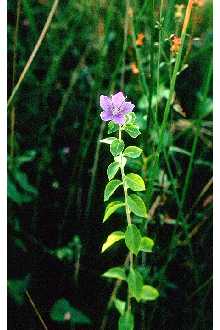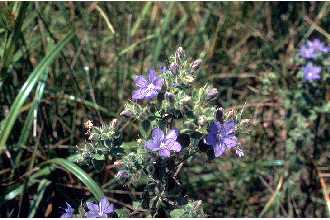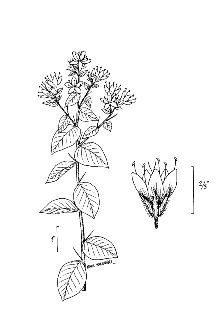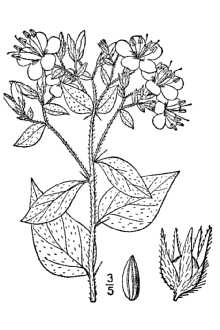Nama ovata (Nutt. ex Choisy) Britton
Scientific Name: Nama ovata (Nutt. ex Choisy) Britton

| General Information | |
|---|---|
| Usda Symbol | NAOV |
| Group | Dicot |
| Life Cycle | Perennial |
| Growth Habits | Forb/herb |
| Native Locations | NAOV |
Plant Guide
Alternate Names
Hairy hydrolea, false fiddleleaf, ovate falsefiddleleaf
Uses
This plant is utilized for wetland restoration.
Status
Please consult the PLANTS Web site and your State Department of Natural Resources for this plant’s current status (e.g. threatened or endangered species, state noxious status, and wetland indicator values).
Description
General: Waterleaf Family (Hydrophyllaceae). Hydrolea ovata, a native, rhizomatous perennial, which rarely reaches a height of more than 2 feet, is a very distinctive plant due to its spiny stems and deep blue flowers. Leaves are entire, alternate, somewhat oval in shape and deep green in color. A single spine (usually 0.5-inch long) arises from each leaf node. No similar genera are found in wet sites in Texas. There are three (some argue 4) species of Hydrolea in Texas. Hydrolea spinosa is more common in south Texas and is very similar to Hydrolea ovata. Hydrolea uniflora is more common in east Texas, eastern Oklahoma, and the southeastern US and does not have very showy flowers. Other species of Hydrolea are found in southeastern U.S. without spines, or only a few spines. All Hydrolea species are found in wet areas and have the deep blue flowers.
Distribution
Found from Texas and Missouri to Florida. For current distribution, please consult the Plant Profile page for this species on the PLANTS Web site.
Establishment
Adaptation: Hydrolea ovata is an obligate wetland plant (found in wetlands 99% of the time) and likes full sun. It is found most commonly in depressions, roadside ditches that pond water for long periods, and ponded areas in pastures of the Gulf Coast Prairie, Pineywoods, and Post-Oak Savanna regions of Texas. It is also very common along livestock pond edges, often forming monoculture stands. Cultivars, Improved and Selected Materials (and area of origin) Contact your local Natural Resources
Conservation
Service (formerly Soil Conservation Service) office for more information, Look in the phone book under ”United States Government,” The Natural Resources Conservation Service will be listed under the subheading “Department of Agriculture,” These plant materials are somewhat available from commercial sources, , Use soil moisture sensors to measure the soil moisture of Nama ovata (Nutt. ex Choisy) Britton.
References
Davis, L. 2000. Texas plant fact sheet: Hydrolea ovata. USDA, NRCS, Nacogdoches Technical Office #2, Nacogdoches, Texas. USDA, NRCS 2000. The PLANTS database. <http://plants.usda.gov>. 001206. National Plant Data Center, Baton Rouge, Louisiana.




